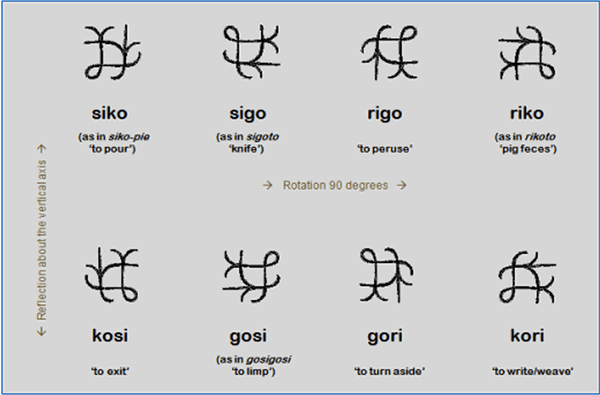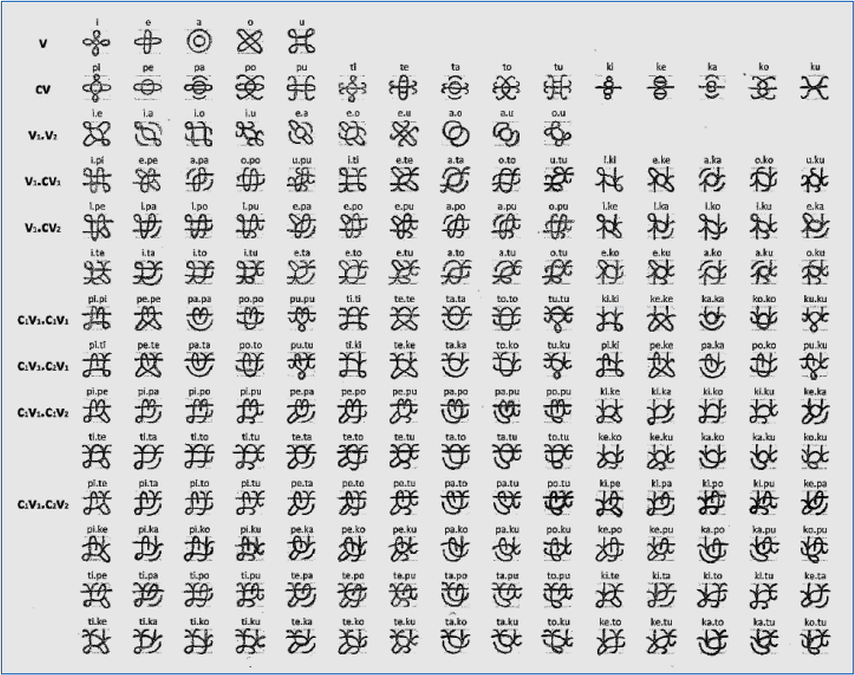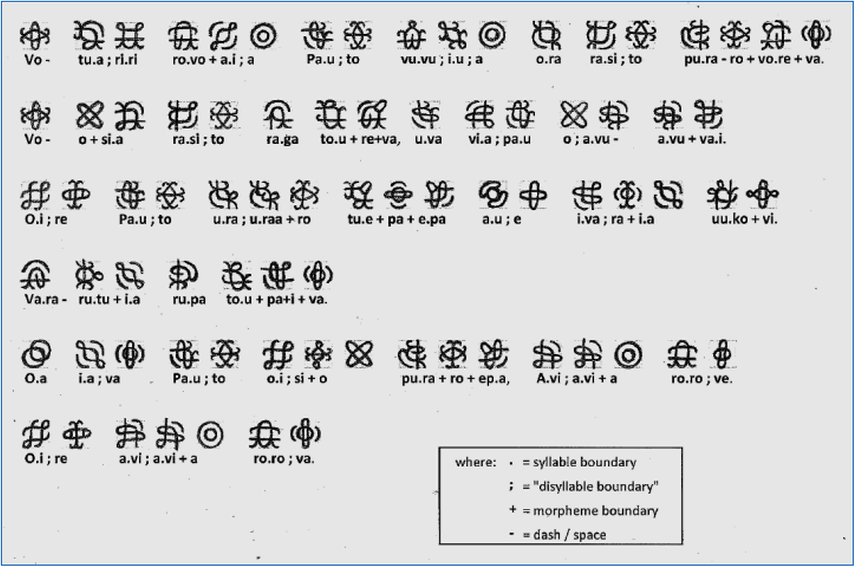
The Uriovakiro script was designed exclusively for a dialect of the Rotokas language (Central Rotokas), spoken by about 4,000 people in Papua New Guinea. Incidentally, the name "Uriova-kiro" comes from the Rotokas words for "bug" and "writing" respectively. This refers to the fact that many of the symbols resemble insects.
The first of its kind, Uriovakiro is herein labelled a "polysyllabary." A polysyllabary is an original type of writing system conceived of in 2013 and 2014 by Sheldon Ebbeler, a linguist and analyst of verbal behavior. For more information on polysyllabaries, or other scripts constructed by Sheldon Ebbeler, please contact the author at sheldonebbeler@yahoo.com. The primary intent of this new writing system was to explore the possibility of extending the classification of writing systems. That is, the traditional broad classes of phonetic writing systems (essentially, "featural," "alphabet," and "syllabary") do not strictly apply to this conscript.
Featural scripts, alphabets, and syllabaries capture more and more phonological material within any given written form, to a degree that increases along a phonetic writing system continuum. Expanding this continuum, we could imagine a further level of poly-phonemic writing classification. Such a system would employ symbols uniquely corresponding to sound groupings above the level of the syllable (e.g, symbols for combinations of 2 syllables). Although such systems* are not known to exist naturally, Uriovakiro is an attempt at a script systematically constructed to explore this possibility: a polysyllabary. That is, Uriovakiro has symbols for not only Rotokas monosyllables (i.e, "monosyllabograms") but also disyllables (i.e, "disyllabograms").
*Note: There are writing systems that encode semantic information instead of (or in addition to) phonetic information (e.g, logographic systems, like Chinese). However, this is not what we are referring to here.
Uriovakiro does not have separate arbitrary symbols for the full range of over 1,200 possible syllables combinations. Rather, a form that represents a particular disyllable is systematically related to other forms representing associated disyllables. This is achieved via compositionality and two universally-applicable rules of symmetry.
1) Compositionality: Technically speaking, Uriovakiro is not a "pure" syllabic writing system, since its syllabograms are systematically related. That syllabograms are compositional means that they can be decoded into their spoken segments. In particular, every syllabogram is divided into 4 quadrants. These quadrants are filled with particular quadrant forms depending upon (1) the specific type of monosyllable or disyllable being represented (cv.cv, v.cv (or cv.v), v.v, cv, or v, where the period indicates a syllable boundary), and (2) the sounds within the syllable(s). Each of the 5 types of syllable combinations gets assigned its own template. Into these templates, the following 8 basic quadrant forms combine in different ways to produce every completed syllabogram.

2) Rotation & Reflection Operations: In addition to being systematically constructed from syllabogram templates and quadrant forms, each syllabogram is read differently depending upon its orientation. As such, any given unique form can represent up to 8 different disyllables. From about 200 unique composite syllabograms, two simple rules of symmetry yield over 1,200 total possible syllable combinations.

Here are the 195 basic syllabograms. Each of these unique forms can represent up 8 disyllable combinations, which result from the operations of reflection and/or rotation. These operations lead us to over 1,200 possible symbols, though only the unique ones are illustrated here.


In the beginning, God created heaven and earth. The earth was formless and empty, The spirit of God was hovering over the water and darkness covered the deep water. Then God said, "Let there be light!" So there was light.
More information about Uriovakiro (PDF)
Funnish, Knot alphabet, Tengwarpt, Uriovakiro
Constructed scripts for: Ainu | Arabic | Chinese languages | Dutch | English | Hawaiian | Hungarian | Japanese | Korean | Lingala | Malay & Indonesian | Persian | Tagalog / Filipino | Russian | Sanskrit | Spanish | Taino | Turkish | Vietnamese | Welsh | Other natural languages | Colour-based scripts | Tactile scripts | Phonetic/universal scripts | Constructed scripts for constructed languages | Adaptations of existing alphabets | Fictional alphabets | Magical alphabets | A-Z index | How to submit a constructed script
[top]
You can support this site by Buying Me A Coffee, and if you like what you see on this page, you can use the buttons below to share it with people you know.

If you like this site and find it useful, you can support it by making a donation via PayPal or Patreon, or by contributing in other ways. Omniglot is how I make my living.
Note: all links on this site to Amazon.com, Amazon.co.uk
and Amazon.fr
are affiliate links. This means I earn a commission if you click on any of them and buy something. So by clicking on these links you can help to support this site.
[top]